Reliability of Obstacle-Crossing Parameters during Overground Walking in Young Adults
Abstract
1. Introduction
2. Materials and Methods
2.1. Participants
2.2. Experimental Protocol
2.3. Gait Assessment
2.4. Statistical Analysis
3. Results
3.1. Difference between Trials
3.2. Absolute and Relative Reliabilities
3.2.1. Spatial–Temporal Gait Parameters during the Approaching Phase
3.2.2. Spatial–Temporal Gait Parameters during the Crossing Phase
3.2.3. Obstacle Clearance Parameters
3.3. Agreement between Trials
3.3.1. Spatial–Temporal Gait Parameters during the Approaching Phase
3.3.2. Spatial–Temporal Gait Parameters during the Crossing Phase
3.3.3. Obstacle Clearance Parameters
4. Discussion
4.1. Intra-Session Reliability during Obstacle-Crossing
4.1.1. Approaching Phase
4.1.2. Crossing Phase
4.1.3. Obstacle Clearance
4.2. Study Limitations, Strengths, and Perspectives
5. Conclusions
Supplementary Materials
Author Contributions
Funding
Institutional Review Board Statement
Informed Consent Statement
Data Availability Statement
Acknowledgments
Conflicts of Interest
References
- Wilken, J.M.; Rodriguez, K.M.; Brawner, M.; Darter, B.J. Reliability and Minimal Detectible Change Values for Gait Kinematics and Kinetics in Healthy Adults. Gait Posture 2012, 35, 301–307. [Google Scholar] [CrossRef]
- Soulard, J.; Vaillant, J.; Balaguier, R.; Vuillerme, N. Spatio-Temporal Gait Parameters Obtained from Foot-Worn Inertial Sensors Are Reliable in Healthy Adults in Single- and Dual-Task Conditions. Sci. Rep. 2021, 11, 10229. [Google Scholar] [CrossRef] [PubMed]
- Couto, A.G.B.; Vaz, M.A.P.; Pinho, L.; Félix, J.; Moreira, J.; Pinho, F.; Mesquita, I.A.; Montes, A.M.; Crasto, C.; Sousa, A.S.P. Repeatability and Temporal Consistency of Lower Limb Biomechanical Variables Expressing Interlimb Coordination during the Double-Support Phase in People with and without Stroke Sequelae. Sensors 2023, 23, 2526. [Google Scholar] [CrossRef] [PubMed]
- Giannouli, E.; Kim, E.K.; Fu, C.; Weibel, R.; Sofios, A.; Infanger, D.; Portegijs, E.; Rantanen, T.; Huang, H.; Schmidt-Trucksäss, A.; et al. Psychometric Properties of the MOBITEC-GP Mobile Application for Real-Life Mobility Assessment in Older Adults. Geriatr. Nurs. 2022, 48, 273–279. [Google Scholar] [CrossRef]
- Olsen, S.; Rashid, U.; Allerby, C.; Brown, E.; Leyser, M.; McDonnell, G.; Alder, G.; Barbado, D.; Shaikh, N.; Lord, S.; et al. Smartphone-Based Gait and Balance Accelerometry Is Sensitive to Age and Correlates with Clinical and Kinematic Data. Gait Posture 2023, 100, 57–64. [Google Scholar] [CrossRef] [PubMed]
- Yavuzer, G.; Öken, Ö.; Elhan, A.; Stam, H.J. Repeatability of Lower Limb Three-Dimensional Kinematics in Patients with Stroke. Gait Posture 2008, 27, 31–35. [Google Scholar] [CrossRef] [PubMed]
- Lefeber, N.; Degelaen, M.; Truyers, C.; Safin, I.; Beckwee, D. Validity and Reproducibility of Inertial Physilog Sensors for Spatiotemporal Gait Analysis in Patients with Stroke. IEEE Trans. Neural Syst. Rehabil. Eng. 2019, 27, 1865–1874. [Google Scholar] [CrossRef] [PubMed]
- Wedege, P.; Steffen, K.; Strøm, V.; Opheim, A.I. Reliability of Three-Dimensional Kinematic Gait Data in Adults with Spinal Cord Injury. J. Rehabil. Assist. Technol. Eng. 2017, 4, 205566831772999. [Google Scholar] [CrossRef]
- Fransen, M.; Crosbie, J.; Edmonds, J. Reliability of Gait Measurements in People with Osteoarthritis of the Knee. Phys. Ther. 1997, 77, 944–953. [Google Scholar] [CrossRef]
- Hansen, C.; Ortlieb, C.; Romijnders, R.; Warmerdam, E.; Welzel, J.; Geritz, J.; Maetzler, W. Reliability of IMU-Derived Temporal Gait Parameters in Neurological Diseases. Sensors 2022, 22, 2304. [Google Scholar] [CrossRef]
- Allet, L.; Armand, S.; de Bie, R.A.; Golay, A.; Monnin, D.; Aminian, K.; de Bruin, E.D. Reliability of Diabetic Patients’ Gait Parameters in a Challenging Environment. Gait Posture 2008, 28, 680–686. [Google Scholar] [CrossRef] [PubMed]
- Brach, J.S.; Perera, S.; Studenski, S.; Newman, A.B. The Reliability and Validity of Measures of Gait Variability in Community-Dwelling Older Adults. Arch. Phys. Med. Rehabil. 2008, 89, 2293–2296. [Google Scholar] [CrossRef]
- Berard, J.R.; Vallis, L.A. Characteristics of Single and Double Obstacle Avoidance Strategies: A Comparison between Adults and Children. Exp. Brain Res. 2006, 175, 21–31. [Google Scholar] [CrossRef] [PubMed]
- Yoshimoto, K.; Mani, H.; Hirose, N.; Kurogi, T.; Aiko, T.; Shinya, M. Dynamic Stability during Level Walking and Obstacle Crossing in Children Aged 2–5 Years Estimated by Marker-Less Motion Capture. Front. Sports Act. Living 2023, 5, 1109581. [Google Scholar] [CrossRef] [PubMed]
- Pavol, M.J.; Owings, T.M.; Foley, K.T.; Grabiner, M.D. Mechanisms Leading to a Fall from an Induced Trip in Healthy Older Adults. J. Gerontol. A Biol. Sci. Med. Sci. 2001, 56, M428–M437. [Google Scholar] [CrossRef]
- Chen, H.C.; Ashton-Miller, J.A.; Alexander, N.B.; Schultz, A.B. Stepping over Obstacles: Gait Patterns of Healthy Young and Old Adults. J. Gerontol. 1991, 46, M196–M203. [Google Scholar] [CrossRef]
- Gill, S.V.; Hung, Y.C. Effects of Overweight and Obese Body Mass on Motor Planning and Motor Skills during Obstacle Crossing in Children. Res. Dev. Disabil. 2014, 35, 46–53. [Google Scholar] [CrossRef]
- Galna, B.; Murphy, A.T.; Morris, M.E. Obstacle Crossing in Parkinson’s Disease: Mediolateral Sway of the Centre of Mass during Level-Ground Walking and Obstacle Crossing. Gait Posture 2013, 38, 790–794. [Google Scholar] [CrossRef]
- dos Santos, P.C.R.; Barbieri, F.A.; Orcioli-Silva, D.; Beretta, V.S.; Hortobágyi, T.; Gobbi, L.T.B. Being Physically Active Minimizes the Effects of Leg Muscle Fatigue on Obstacle Negotiation in People with Parkinson’s Disease. J. Biomech. 2021, 124, 110568. [Google Scholar] [CrossRef]
- Penedo, T.; Polastri, P.F.; Rodrigues, S.T.; Simieli, L.; Baptista, A.M.; Moretto, G.F.; Imaizumi, L.F.I.; Santinelli, F.B.; Barbieri, F.A. Influence of Obstacle Color on Locomotor and Gaze Behaviors during Obstacle Avoidance in People with Parkinson’s Disease. Exp. Brain Res. 2018, 236, 3319–3325. [Google Scholar] [CrossRef]
- Simieli, L.; Gobbi, L.T.B.; Orcioli-Silva, D.; Beretta, V.S.; Santos, P.C.R.; Baptista, A.M.; Barbieri, F.A. The Variability of the Steps Preceding Obstacle Avoidance (Approach Phase) Is Dependent on the Height of the Obstacle in People with Parkinson’s Disease. PLoS ONE 2017, 12, e0184134. [Google Scholar] [CrossRef]
- Santinelli, F.B.; Sebastião, E.; Kuroda, M.H.; Moreno, V.C.; Pilon, J.; Vieira, L.H.P.; Barbieri, F.A. Cortical Activity and Gait Parameter Characteristics in People with Multiple Sclerosis during Unobstructed Gait and Obstacle Avoidance. Gait Posture 2021, 86, 226–232. [Google Scholar] [CrossRef]
- Chou, L.S.; Kaufman, K.R.; Walker-Rabatin, A.E.; Brey, R.H.; Basford, J.R. Dynamic Instability during Obstacle Crossing Following Traumatic Brain Injury. Gait Posture 2004, 20, 245–254. [Google Scholar] [CrossRef] [PubMed]
- Den Otter, A.R.; Geurts, A.C.H.; De Haart, M.; Mulder, T.; Duysens, J. Step Characteristics during Obstacle Avoidance in Hemiplegic Stroke. Exp. Brain Res. 2005, 161, 180–192. [Google Scholar] [CrossRef]
- Said, C.M.; Galea, M.; Lythgo, N. Obstacle Crossing Following Stroke Improves over One Month When the Unaffected Limb Leads, but Not When the Affected Limb Leads. Gait Posture 2014, 39, 213–217. [Google Scholar] [CrossRef] [PubMed]
- Scalvini, F.; Bordeau, C.; Ambard, M.; Migniot, C.; Vergnaud, M.; Dubois, J. UB-VisioGeoloc: An Image Sequences Dataset of Pedestrian Navigation Including Geolocalised-Inertial Information and Spatial Sound Rendering of the Urban Environment’s Obstacles. Data Brief. 2024, 53, 110088. [Google Scholar] [CrossRef]
- Soma, M.; Nakae, H.; Abiko, T.; Shimamura, R.; Uematsu, H.; Kawama, K. Influence of a Dual Task While Stepping Over an Obstacle in the Fall-Experienced Elderly People. J. Phys. Ther. Sci. 2011, 23, 369–372. [Google Scholar] [CrossRef][Green Version]
- Weerdesteyn, V.; Nienhuis, B.; Duysens, J. Advancing Age Progressively Affects Obstacle Avoidance Skills in the Elderly. Hum. Mov. Sci. 2005, 24, 865–880. [Google Scholar] [CrossRef] [PubMed]
- Gök, H.; Ergin, S.; Yavuzer, G. Reliability of Gait Measurements in Normal Subjects. J. Rheumatol. Med. Rehabil. 2002, 13, 76–80. [Google Scholar]
- Boldo, M.; Di Marco, R.; Martini, E.; Nardon, M.; Bertucco, M.; Bombieri, N. On the Reliability of Single-Camera Markerless Systems for Overground Gait Monitoring. Comput. Biol. Med. 2024, 171, 108101. [Google Scholar] [CrossRef]
- van Bloemendaal, M.; Beelen, A.; Kleissen, R.F.M.; Geurts, A.C.H.; Nollet, F.; Bus, S.A. Concurrent Validity and Reliability of a Low-Cost Gait Analysis System for Assessment of Spatiotemporal Gait Parameters. J. Rehabil. Med. 2019, 51, 456–463. [Google Scholar] [CrossRef] [PubMed]
- Widhalm, K.; Durstberger, S.; Greisberger, A.; Wolf, B.; Putz, P. Validity of Assessing Level Walking with the 2D Motion Analysis Software TEMPLO and Reliability of 3D Marker Application. Sci. Rep. 2024, 14, 1427. [Google Scholar] [CrossRef]
- Girard, O.; Brocherie, F.; Morin, J.B.; Millet, G.P. Intrasession and Intersession Reliability of Running Mechanics During Treadmill Sprints. Int. J. Sports Physiol. Perform. 2016, 11, 432–439. [Google Scholar] [CrossRef] [PubMed]
- Pinsault, N.; Vuillerme, N. Test-Retest Reliability of Centre of Foot Pressure Measures to Assess Postural Control during Unperturbed Stance. Med. Eng. Phys. 2009, 31, 276–286. [Google Scholar] [CrossRef]
- Pinsault, N.; Fleury, A.; Virone, G.; Bouvier, B.; Vaillant, J.; Vuillerme, N. Test-Retest Reliability of Cervicocephalic Relocation Test to Neutral Head Position. Physiother. Theory Pract. 2008, 24, 380–391. [Google Scholar] [CrossRef]
- Balaguier, R.; Madeleine, P.; Vuillerme, N. Is One Trial Sufficient to Obtain Excellent Pressure Pain Threshold Reliability in the Low Back of Asymptomatic Individuals? A Test-Retest Study. PLoS ONE 2016, 11, e0160866. [Google Scholar] [CrossRef] [PubMed]
- Balaguier, R.; Madeleine, P.; Vuillerme, N. Intra-Session Absolute and Relative Reliability of Pressure Pain Thresholds in the Low Back Region of Vine-Workers: Effect of the Number of Trials. BMC Musculoskelet. Disord. 2016, 17, 350. [Google Scholar] [CrossRef] [PubMed]
- Soulard, J.; Vaillant, J.; Balaguier, R.; Baillet, A.; Gaudin, P.; Vuillerme, N. Foot-Worn Inertial Sensors Are Reliable to Assess Spatiotemporal Gait Parameters in Axial Spondyloarthritis under Single and Dual Task Walking in Axial Spondyloarthritis. Sensors 2020, 20, 6453. [Google Scholar] [CrossRef] [PubMed]
- Linek, P.; Sikora, D.; Wolny, T.; Saulicz, E. Reliability and Number of Trials of Y Balance Test in Adolescent Athletes. Musculoskelet. Sci. Pract. 2017, 31, 72–75. [Google Scholar] [CrossRef]
- Karatrantou, K.; Xagorari, A.; Vasilopoulou, T.; Gerodimos, V. Does the Number of Trials Affect the Reliability of Handgrip Strength Measurement in Individuals with Intellectual Disabilities? Hand Surg. Rehabil. 2020, 39, 223–228. [Google Scholar] [CrossRef]
- Pineda, R.C.; Krampe, R.T.; Vanlandewijck, Y.; Van Biesen, D. Reliability of Center of Pressure Excursion as a Measure of Postural Control in Bipedal Stance of Individuals with Intellectual Disability: A Pilot Study. PLoS ONE 2020, 15, e0240702. [Google Scholar] [CrossRef]
- Severin, A.C.; Barnes, S.G.; Tackett, S.A.; Barnes, C.L.; Mannen, E.M. The Required Number of Trials for Biomechanical Analysis of a Golf Swing. Sports Biomech. 2021, 20, 238–246. [Google Scholar] [CrossRef] [PubMed]
- Seuthe, J.; D’Cruz, N.; Ginis, P.; Blöbaum, R.; Weisser, B.; Deuschl, G.; Nieuwboer, A.; Schlenstedt, C. How Many Gait Initiation Trials Are Necessary to Reliably Detect Anticipatory Postural Adjustments and First Step Characteristics in Healthy Elderly and People with Parkinson’s Disease? Gait Posture 2021, 88, 126–131. [Google Scholar] [CrossRef]
- Silva, A.F.; Nobari, H.; Badicu, G.; Ceylan, H.I.; Lima, R.; Lagoa, M.J.; Luz, C.; Clemente, F.M. Reliability Levels of Motor Competence in Youth Athletes. BMC Pediatr. 2022, 22, 430. [Google Scholar] [CrossRef] [PubMed]
- Coleman, J.L.; Huynh, M.; Middleton, K.J. Number of Trials Necessary to Achieve a Representative Performance of Accuracy and Timing during Combat Shooting. Scand. J. Med. Sci. Sports 2023, 33, 2039–2045. [Google Scholar] [CrossRef] [PubMed]
- Villarrasa-Sapiña, I.; Ortega-Benavent, N.; Monfort-Torres, G.; Ramon-Llin, J.; García-Massó, X. Test-Retest Reliability of Task Performance for Golf Swings of Medium- to High-Handicap Players. Sensors 2022, 22, 9069. [Google Scholar] [CrossRef] [PubMed]
- García-Massó, X.; Villarrasa-Sapiña, I.; Ortega-Benavent, N.; Montalt-García, S.; Toca-Herrera, J.L. Test-Retest Reliability of Putting-Related Variables in Medium-to-High Handicap Golf Players. Sci. Rep. 2024, 14, 11516. [Google Scholar] [CrossRef]
- Monaghan, K.; Delahunt, E.; Caulfield, B. Increasing the Number of Gait Trial Recordings Maximises Intra-Rater Reliability of the CODA Motion Analysis System. Gait Posture 2007, 25, 303–315. [Google Scholar] [CrossRef] [PubMed]
- Santinelli, F.B.; Sebastião, E.; Simieli, L.; Antunes, B.M.; Vieira, L.H.P.; Kalron, A.; Barbieri, F.A. Is BDNF Related to Spatial-Temporal Gait Parameters in People with Multiple Sclerosis? An Observational Study. Mult. Scler. Relat. Disord. 2022, 66, 104064. [Google Scholar] [CrossRef]
- Barbieri, F.A.; dos Santos, P.C.R.; Simieli, L.; Orcioli-Silva, D.; van Dieën, J.H.; Gobbi, L.T.B. Interactions of Age and Leg Muscle Fatigue on Unobstructed Walking and Obstacle Crossing. Gait Posture 2014, 39, 985–990. [Google Scholar] [CrossRef]
- Landis, J.; Koch, G. The Measurement of Observer Agreement for Categorical Data. Biometrics 1977, 33, 159–174. [Google Scholar] [CrossRef] [PubMed]
- Harvill, L.M. Standard Error of Measurement. Educ. Meas. Issues Pract. 1991, 10, 33–41. [Google Scholar] [CrossRef]
- Walton, D.; Macdermid, J.; Nielson, W.; Teasell, R.; Chiasson, M.; Brown, L. Reliability, Standard Error, and Minimum Detectable Change of Clinical Pressure Pain Threshold Testing in People with and without Acute Neck Pain. J. Orthop. Sports Phys. Ther. 2011, 41, 644–650. [Google Scholar] [CrossRef] [PubMed]
- Weir, J.P. Quantifying Test-Retest Reliability Using the Intraclass Correlation Coefficient and the SEM. J. Strength. Cond. Res. 2005, 19, 231–240. [Google Scholar] [CrossRef] [PubMed]
- Bourke, A.K.; Scotland, A.; Lipsmeier, F.; Gossens, C.; Lindemann, M. Gait Characteristics Harvested During a Smartphone-Based Self-Administered 2-Minute Walk Test in People with Multiple Sclerosis: Test-Retest Reliability and Minimum Detectable Change. Sensors 2020, 20, 5906. [Google Scholar] [CrossRef]
- Huang, S.L.; Hsieh, C.L.; Wu, R.M.; Lu, W.S. Test-Retest Reliability and Minimal Detectable Change of the Beck Depression Inventory and the Taiwan Geriatric Depression Scale in Patients with Parkinson’s Disease. PLoS ONE 2017, 12, e0184823. [Google Scholar] [CrossRef]
- Feng, D.; Baumgartner, R.; Svetnik, V. A Short Note on Jackknifing the Concordance Correlation Coefficient. Stat. Med. 2014, 33, 514–516. [Google Scholar] [CrossRef] [PubMed]
- Gillinov, S.; Etiwy, M.; Wang, R.; Blackburn, G.; Phelan, D.; Gillinov, A.M.; Houghtaling, P.; Javadikasgari, H.; Desai, M.Y. Variable Accuracy of Wearable Heart Rate Monitors during Aerobic Exercise. Med. Sci. Sports Exerc. 2017, 49, 1697–1703. [Google Scholar] [CrossRef]
- Shieh, G. Assessing Individual Equivalence in Parallel Group and Crossover Designs: Exact Test and Sample Size Procedures. PLoS ONE 2022, 17, e0269128. [Google Scholar] [CrossRef]
- Quinn, C.; Haber, M.J.; Pan, Y. Use of the Concordance Correlation Coefficient When Examining Agreement in Dyadic Research. Nurs. Res. 2009, 58, 368–373. [Google Scholar] [CrossRef]
- Buchheit, M. Magnitudes Matter More than Beetroot Juice. Sport Perform. Sci. Rep. 2018, 1, 1–3. [Google Scholar]
- MacLellan, M.J.; McFadyen, B.J. Proximal Lower Limb Muscle Energetics and the Adaptation of Segment Elevation Angle Phasing for Obstacle Avoidance. Gait Posture 2013, 37, 274–279. [Google Scholar] [CrossRef] [PubMed]
- Billington, J.; Wilkie, R.M.; Wann, J.P. Obstacle Avoidance and Smooth Trajectory Control: Neural Areas Highlighted during Improved Locomotor Performance. Front. Behav. Neurosci. 2013, 7, 9. [Google Scholar] [CrossRef] [PubMed][Green Version]
- Punt, M.; Bruijn, S.M.; Wittink, H.; van de Port, I.G.; Wubbels, G.; van Dieën, J.H. Virtual Obstacle Crossing: Reliability and Differences in Stroke Survivors Who Prospectively Experienced Falls or No Falls. Gait Posture 2017, 58, 533–538. [Google Scholar] [CrossRef]
- Said, C.M.; Galea, M.; Lythgo, N. Obstacle Crossing Performance Does Not Differ between the First and Subsequent Attempts in People with Stroke. Gait Posture 2009, 30, 455–458. [Google Scholar] [CrossRef] [PubMed]
- Grinberg, A.; Strong, A.; Buck, S.; Selling, J.; Häger, C.K. An Obstacle Clearance Test for Evaluating Sensorimotor Control after Anterior Cruciate Ligament Injury: A Kinematic Analysis. J. Orthop. Res. 2022, 40, 105–116. [Google Scholar] [CrossRef] [PubMed]
- Wu, A.R.; Simpson, C.S.; van Asseldonk, E.H.F.; van der Kooij, H.; Ijspeert, A.J. Mechanics of Very Slow Human Walking. Sci. Rep. 2019, 9, 18079. [Google Scholar] [CrossRef] [PubMed]
- Lordall, J.; Bruno, P.; Ryan, N. Assessment of Diurnal Variation of Stride Time Variability during Continuous, Overground Walking in Healthy Young Adults. Gait Posture 2020, 79, 108–110. [Google Scholar] [CrossRef] [PubMed]
- Ryan, N.S.; Bruno, P.A.; Barden, J.M. Test-Retest Reliability and the Effects of Walking Speed on Stride Time Variability During Continuous, Overground Walking in Healthy Young Adults. J. Appl. Biomech. 2021, 37, 102–108. [Google Scholar] [CrossRef]
- Chardon, M.; Barbieri, F.A.; Penedo, T.; Santos, P.C.R.; Vuillerme, N. A Systematic Review of the Influence of Overweight and Obesity across the Lifespan on Obstacle Crossing during Walking. Int. J. Environ. Res. Public. Health 2023, 20, 5931. [Google Scholar] [CrossRef]
- Galna, B.; Peters, A.; Murphy, A.T.; Morris, M.E. Obstacle Crossing Deficits in Older Adults: A Systematic Review. Gait Posture 2009, 30, 270–275. [Google Scholar] [CrossRef] [PubMed]
- Muroi, D.; Ohtera, S.; Kataoka, Y.; Banno, M.; Tsujimoto, Y.; Tsujimoto, H.; Higuchi, T. Obstacle Avoidance Training for Individuals with Stroke: A Systematic Review and Meta-Analysis. BMJ Open 2019, 9, e028873. [Google Scholar] [CrossRef] [PubMed]
- Cloutier, M.; Delucia, P.R. Topical Review: Impact of Central Vision Loss on Navigation and Obstacle Avoidance While Walking. Optom. Vis. Sci. 2022, 99, 890–899. [Google Scholar] [CrossRef] [PubMed]
- Caparrós-Manosalva, C.; Espinoza, J.; Caballero, P.M.; da Cunha, M.J.; Yang, F.; Galen, S.; Pagnussat, A.S. Movement Strategies during Obstacle Crossing in People with Parkinson Disease: A Systematic Review with Meta-Analysis. PM R 2024, 1–14. [Google Scholar] [CrossRef] [PubMed]
- Chardon, M.; Barbieri, F.A.; Penedo, T.; Santos, P.C.R.; Vuillerme, N. The Effects of Experimentally-Induced Fatigue on Gait Parameters during Obstacle Crossing: A Systematic Review. Neurosci. Biobehav. Rev. 2022, 142, 104854. [Google Scholar] [CrossRef] [PubMed]
- Guadagnin, E.C.; da Rocha, E.S.; Duysens, J.; Carpes, F.P. Does Physical Exercise Improve Obstacle Negotiation in the Elderly? A Systematic Review. Arch. Gerontol. Geriatr. 2016, 64, 138–145. [Google Scholar] [CrossRef]
- Muir, B.C.; Haddad, J.M.; Heijnen, M.J.H.; Rietdyk, S. Proactive Gait Strategies to Mitigate Risk of Obstacle Contact Are More Prevalent with Advancing Age. Gait Posture 2015, 41, 233–239. [Google Scholar] [CrossRef] [PubMed]
- Chen, S.H.; Lo, O.Y.; Kay, T.; Chou, L.S. Concurrent Phone Texting Alters Crossing Behavior and Induces Gait Imbalance during Obstacle Crossing. Gait Posture 2018, 62, 422–425. [Google Scholar] [CrossRef] [PubMed]
- Raffegeau, T.E.; Brinkerhoff, S.A.; Kellaher, G.K.; Baudendistel, S.; Terza, M.J.; Roper, J.A.; Hass, C.J. Changes to Margins of Stability from Walking to Obstacle Crossing in Older Adults While Walking Fast and with a Dual-Task. Exp. Gerontol. 2022, 161, 111710. [Google Scholar] [CrossRef]
- Fingerhut, L.A.; Cox, C.; Warner, M. International Comparative Analysis of Injury Mortality. Findings from the ICE on Injury Statistics. International Collaborative Effort on Injury Statistics. Adv. Data 1998, 303, 1–20. [Google Scholar]
- Voss, T.S.; Elm, J.J.; Wielinski, C.L.; Aminoff, M.J.; Bandyopadhyay, D.; Chou, K.L.; Sudarsky, L.R.; Tilley, B.C. Fall Frequency and Risk Assessment in Early Parkinson’s Disease. Parkinsonism Relat. Disord. 2012, 18, 837–841. [Google Scholar] [CrossRef] [PubMed][Green Version]
- Wickham, H.; Averick, M.; Bryan, J.; Chang, W.; D’, L.; Mcgowan, A.; François, R.; Grolemund, G.; Hayes, A.; Henry, L.; et al. Welcome to the Tidyverse. J. Open Source Softw. 2019, 4, 1686. [Google Scholar] [CrossRef]
- Kassambara, A. Pipe-Friendly Framework for Basic Statistical Tests [R Package Rstatix Version 0.7.2]. 2023. [Google Scholar]
- Revelle, W. Procedures for Psychological, Psychometric, and Personality Research [R Package Psych Version 2.4.3]. 2024. [Google Scholar]
- Huebner, A.; McGinn, T.; Sisk, M. psr: Functions for Analyzing Performance Science Data. 2021. [Google Scholar]
- Caldwell, A. SimplyAgree: An R Package and Jamovi Module for Simplifying Agreement and Reliability Analyses. J. Open Source Softw. 2022, 7, 4148. [Google Scholar] [CrossRef]
- Datta, D. blandr: A Bland-Altman Method Comparison package for R. Zenodo. 2017. [Google Scholar]

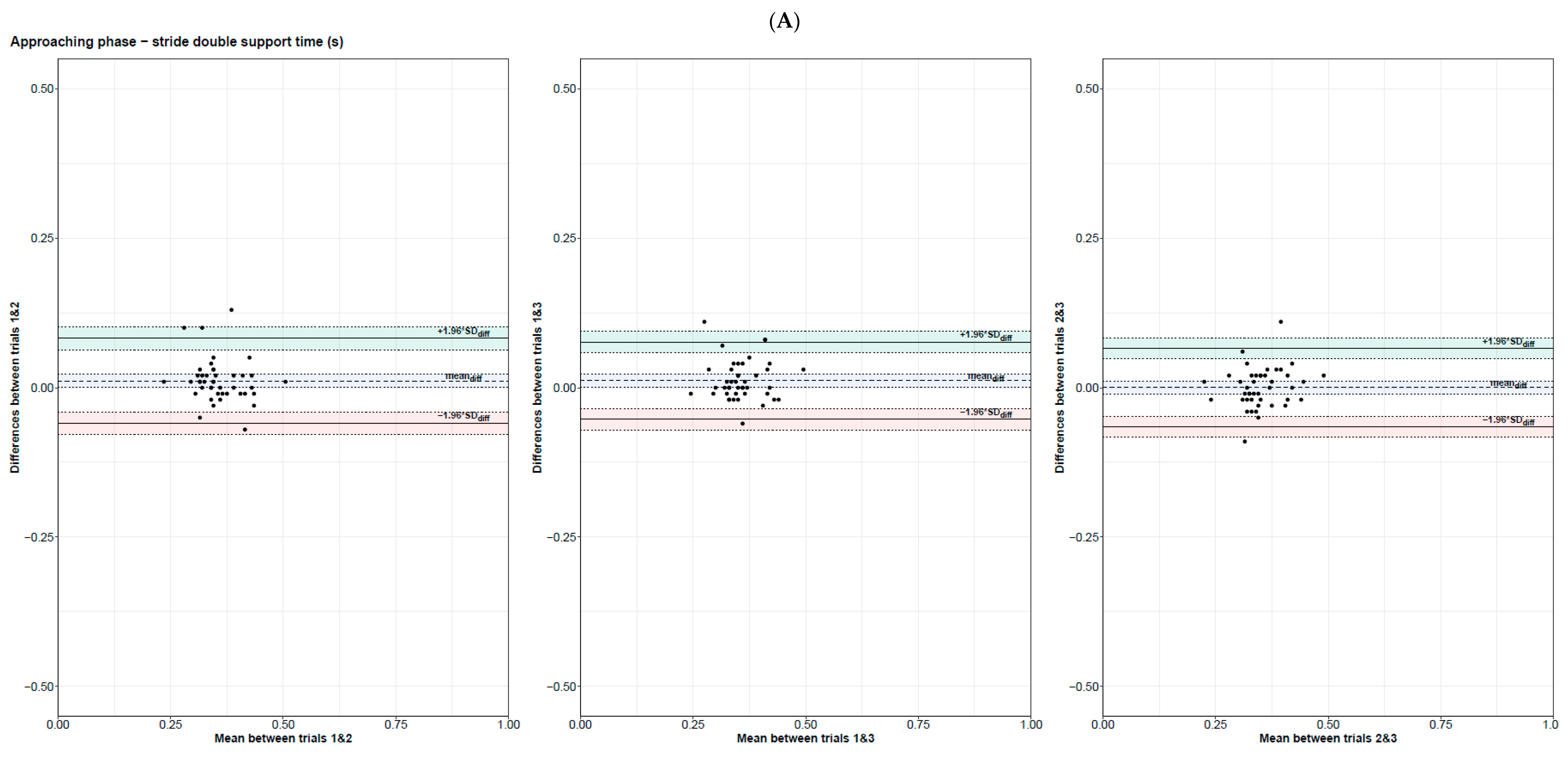

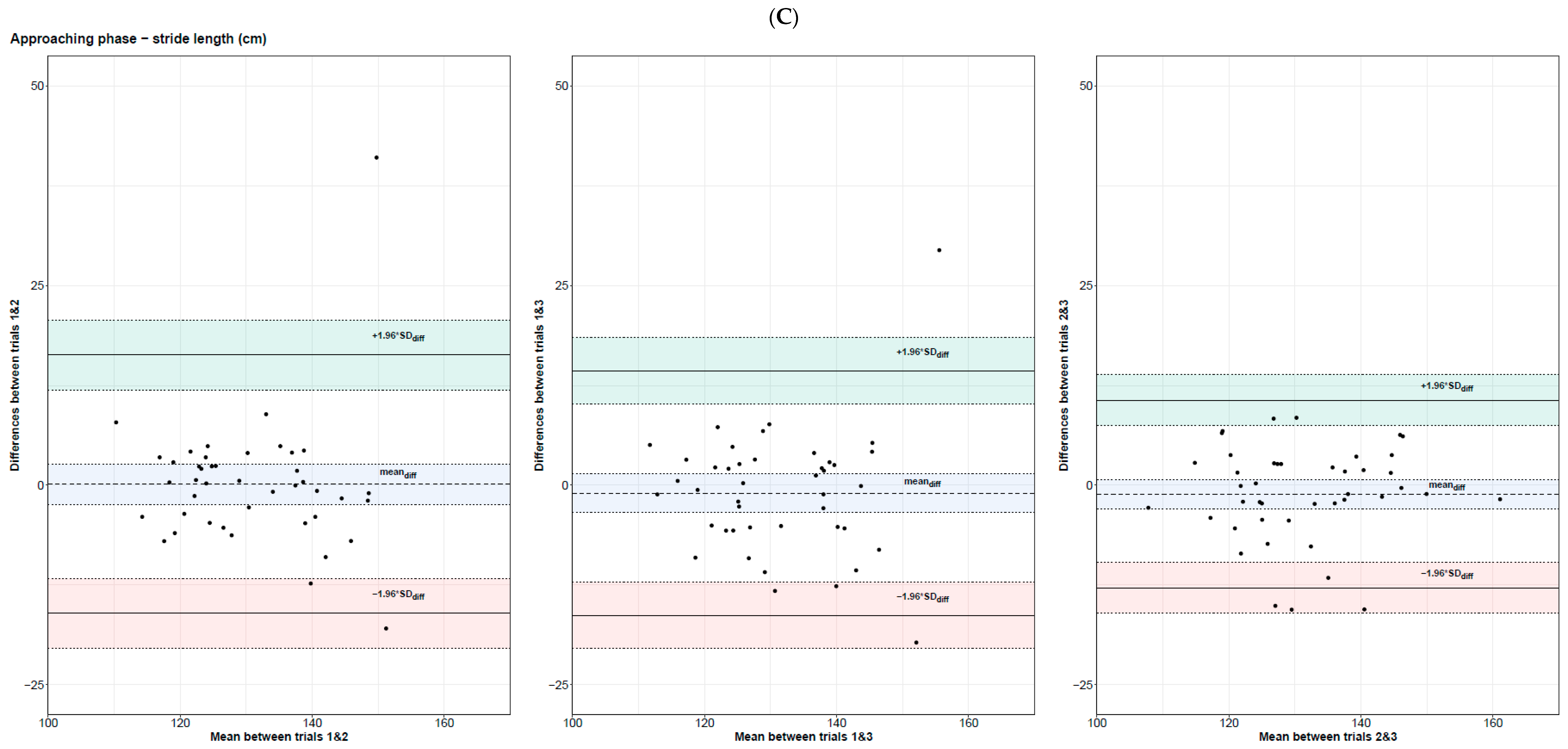
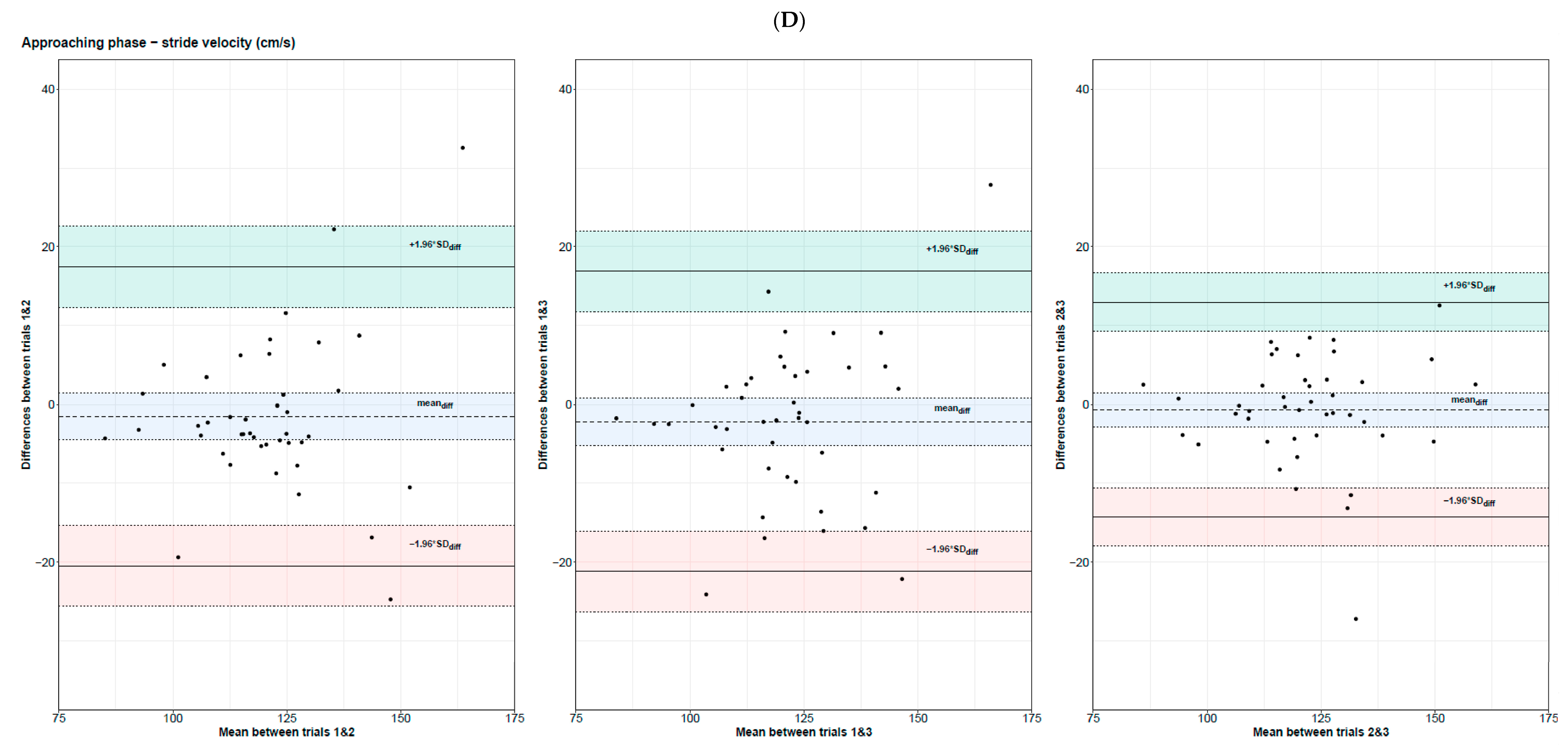

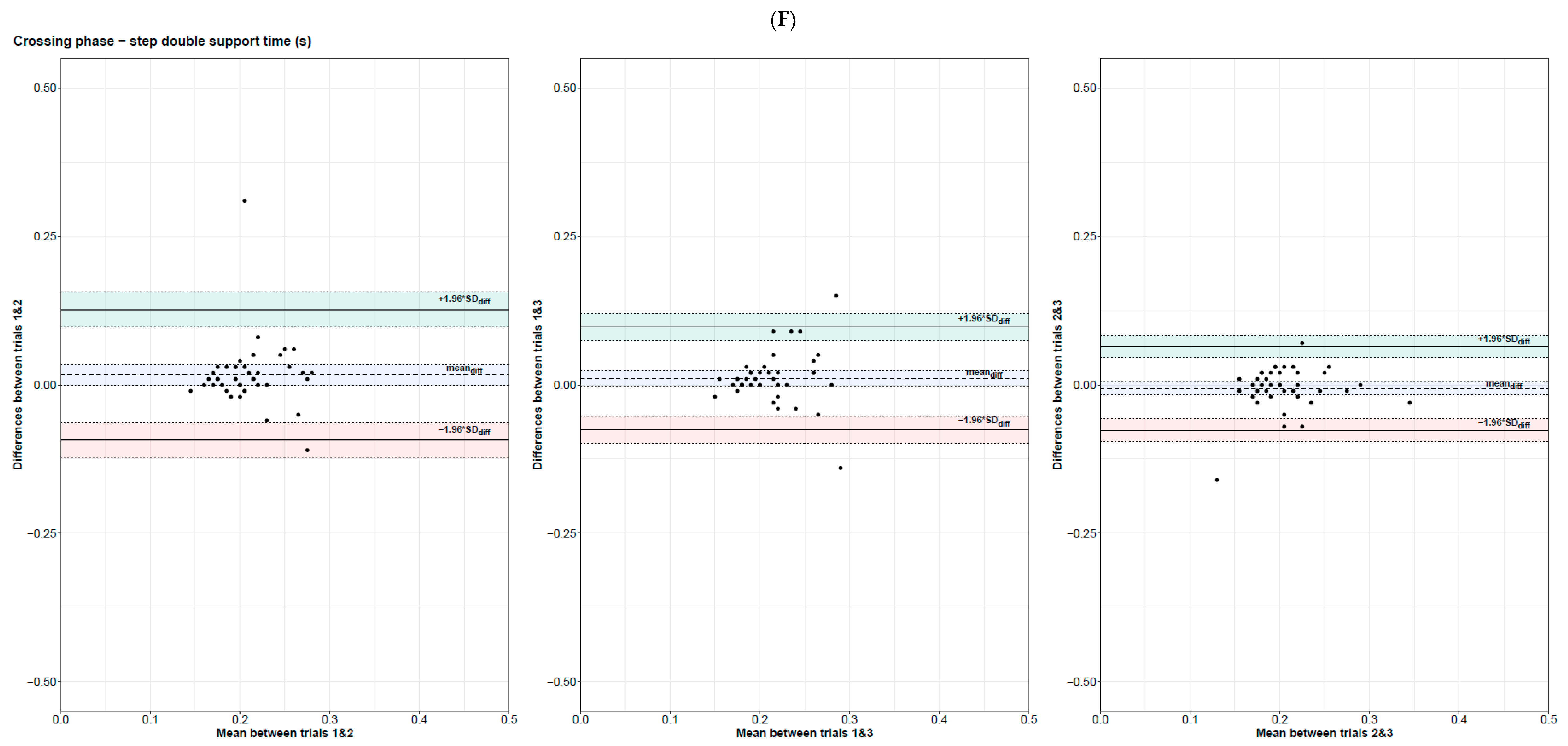

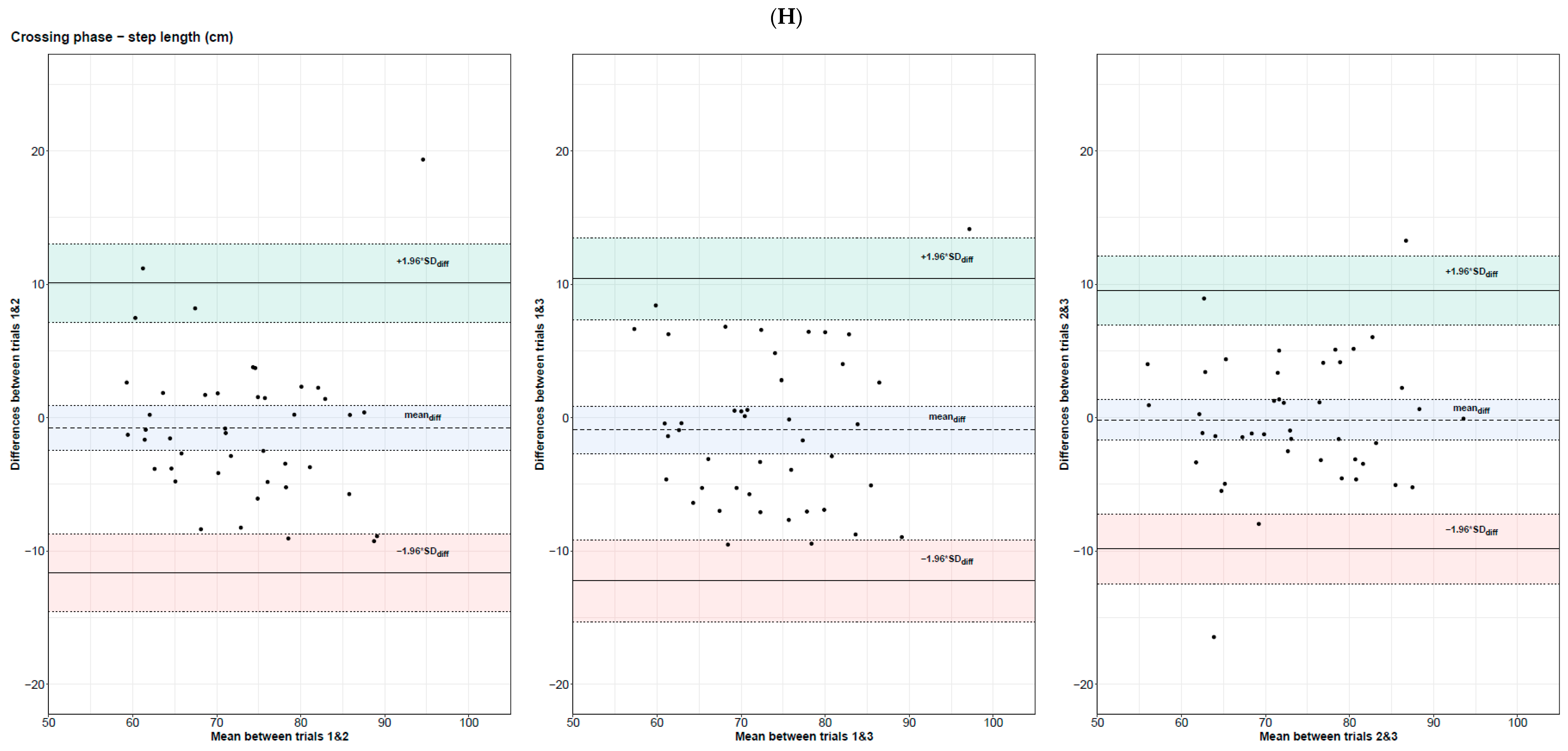
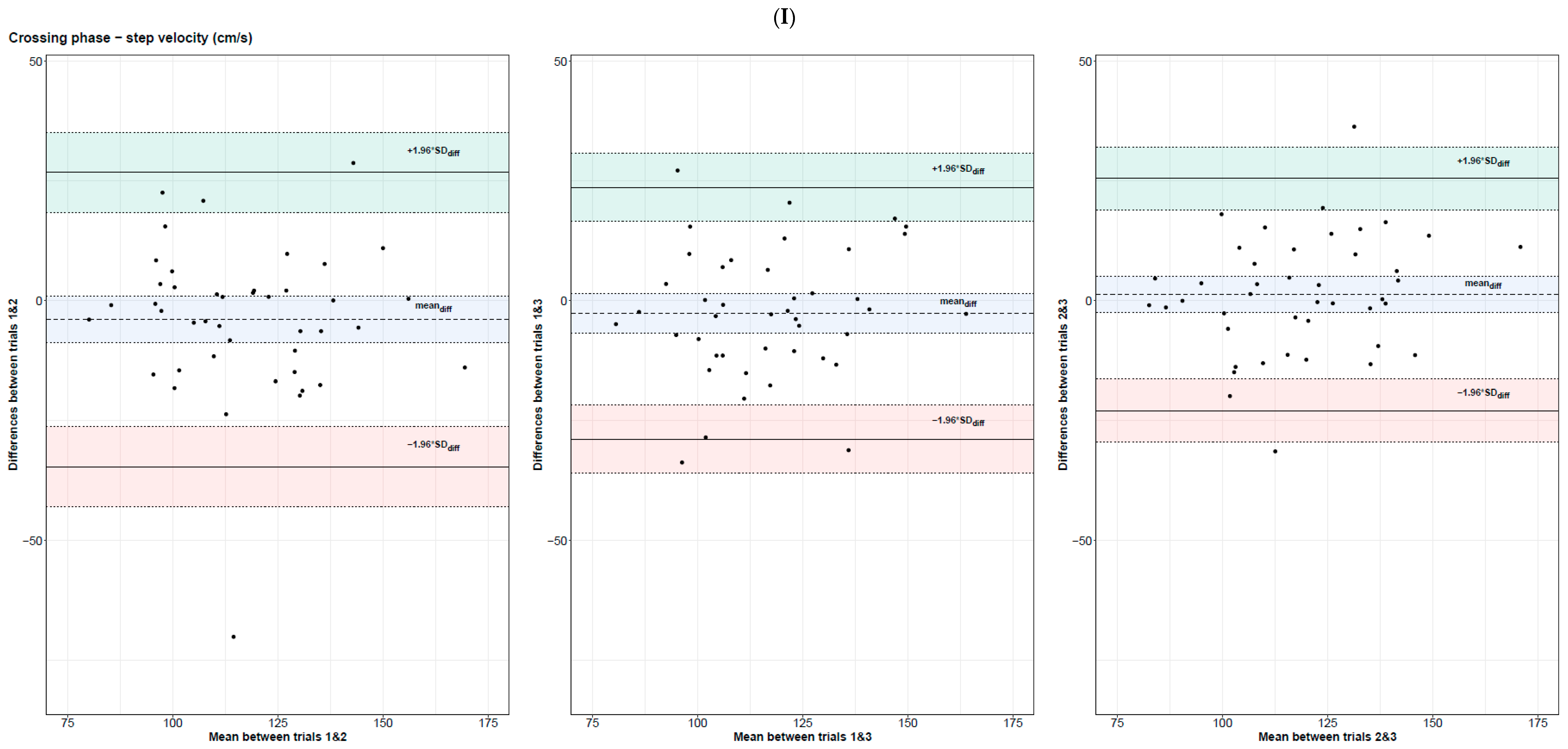

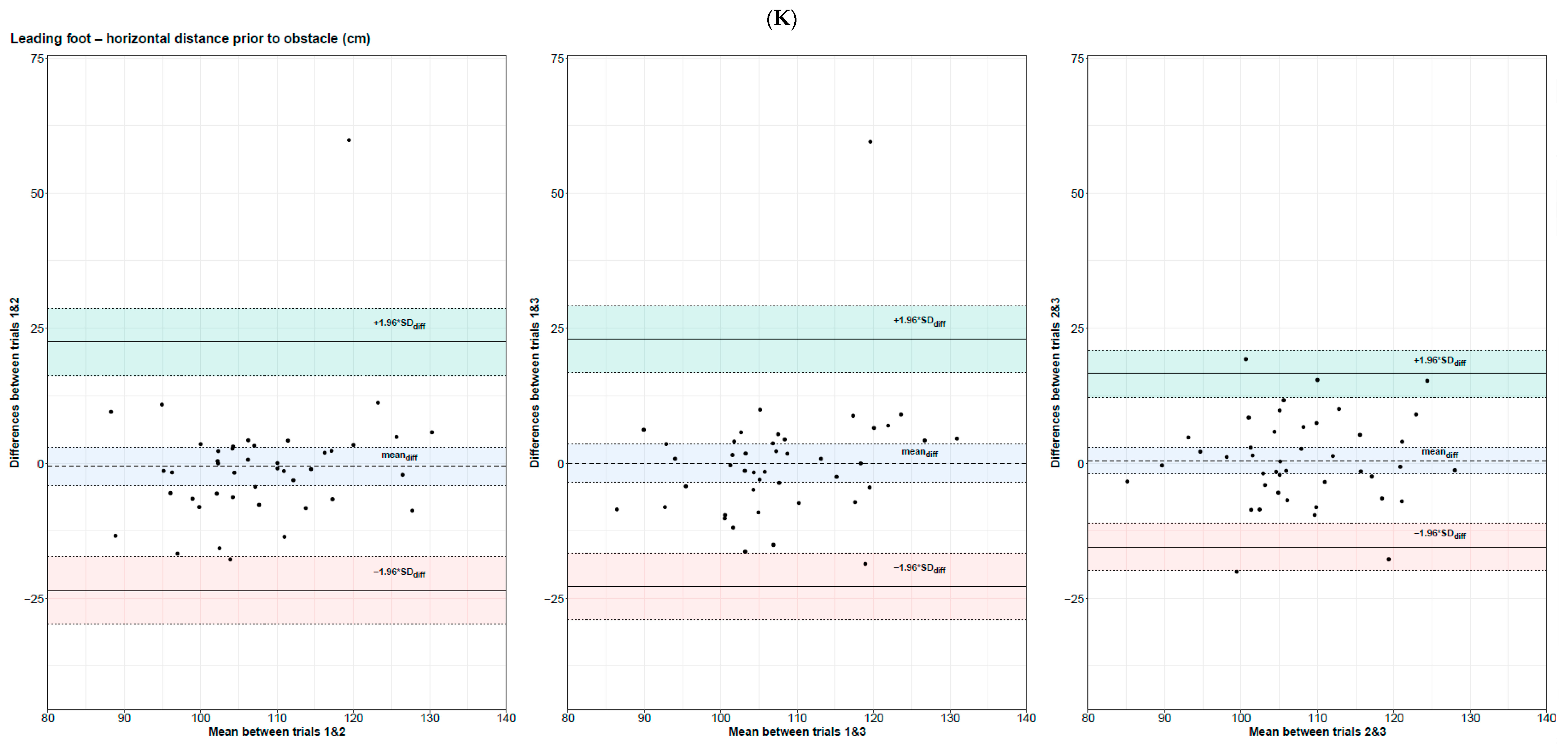
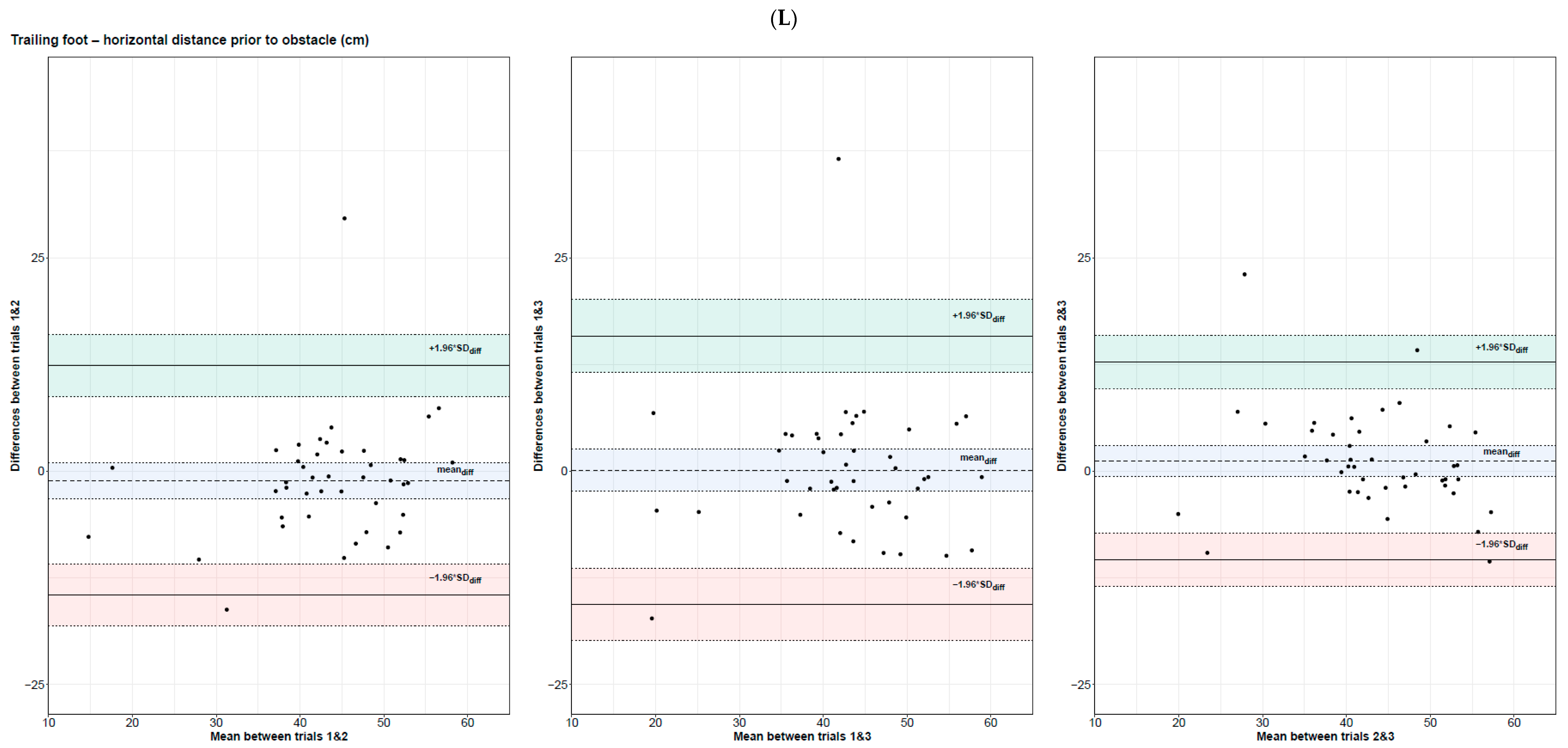




| Condition | Parameter | T1 | T2 | T3 | T123 |
|---|---|---|---|---|---|
| Mean (SD) | Mean (SD) | Mean (SD) | Mean (SD) | ||
| Approaching phase | Stride double support time (s) | 0.36 (0.05) | 0.35 (0.06) | 0.35 (0.05) | 0.36 (0.05) |
| Stride duration (s) | 1.10 (0.13) | 1.09 (0.11) | 1.09 (0.10) | 1.09 (0.11) | |
| Stride length (cm) | 131 (11.4) | 131 (11.5) | 132 (11.2) | 131 (11.3) | |
| Stride velocity (cm/s) | 120 (17.2) | 122 (15.5) | 122 (15.4) | 121 (15.9) | |
| Stride width (cm) | 10.6 (2.49) | 11.3 (2.74) | 11.2 (2.86) | 11.0 (2.70) | |
| Crossing phase | Step double support time (s) | 0.22 (0.04) | 0.20 (0.05) | 0.21 (0.04) | 0.21 (0.04) |
| Step duration (s) | 0.64 (0.08) | 0.62 (0.07) | 0.63 (0.07) | 0.63 (0.07) | |
| Step length (cm) | 72.7 (9.49) | 73.4 (9.78) | 73.6 (9.33) | 73.2 (9.47) | |
| Step velocity (cm/s) | 115 (20.8) | 119 (21.5) | 118 (19.0) | 118 (20.4) | |
| Step width (cm) | 10.2 (3.40) | 10.4 (3.80) | 10.1 (3.79) | 10.2 (3.64) | |
| Obstacle clearance | Leading foot horizontal distance prior to obstacle (cm) | 108 (13.0) | 108 (10.4) | 108 (10.1) | 108 (11.1) |
| Trailing foot horizontal distance prior to obstacle (cm) | 43.0 (10.3) | 44.1 (8.77) | 42.9 (10.1) | 43.3 (9.71) | |
| Leading foot horizontal distance after obstacle (cm) | 25.7 (6.61) | 25.0 (6.63) | 26.8 (7.75) | 25.8 (7.00) | |
| Trailing foot horizontal distance after obstacle (cm) | 91.6 (11.5) | 91.8 (10.4) | 95.0 (12.1) | 92.8 (11.4) | |
| Leading foot toe clearance (cm) | 9.93 (4.21) | 9.99 (4.37) | 10.8 (5.19) | 10.2 (4.59) | |
| Trailing foot toe clearance (cm) | 31.4 (8.68) | 32.2 (8.01) | 32.0 (6.53) | 31.9 (7.74) |
| Condition | Parameter | T1–T2 | T1–T3 | T2–T3 | T1–T2–T3 | ||||||||||||||||
|---|---|---|---|---|---|---|---|---|---|---|---|---|---|---|---|---|---|---|---|---|---|
| ICC(2.1) [95%CI] | MDC | MDC% | SEM | SEM% | ICC [95%CI] | MDC | MDC% | SEM | SEM% | ICC(2.1) [95%CI] | MDC | MDC% | SEM | SEM% | ICC(2.1) [95%CI] | MDC | MDC% | SEM | SEM% | ||
| Approaching phase | Stride length (cm) | 0.75 [0.58; 0.85] | 15.9 | 12.2 | 5.75 | 4.40 | 0.76 [0.60; 0.86] | 15.2 | 11.6 | 5.48 | 4.18 | 0.86 [0.76; 0.92] | 11.7 | 8.94 | 4.23 | 3.23 | 0.79 [0.68; 0.87] | 14.4 | 11.0 | 5.19 | 3.96 |
| Stride width (cm) | 0.74 [0.55; 0.85] | 3.71 | 34.0 | 1.34 | 12.3 | 0.74 [0.56; 0.85] | 3.81 | 35.0 | 1.37 | 12.6 | 0.76 [0.61; 0.87] | 3.75 | 33.4 | 1.35 | 12.1 | 0.75 [0.62; 0.84] | 3.76 | 34.2 | 1.35 | 12.3 | |
| Stride double support time (s) | 0.76 [0.60; 0.87] | 0.07 | 20.4 | 0.03 | 7.36 | 0.77 [0.61; 0.87] | 0.07 | 18.8 | 0.02 | 6.78 | 0.81 [0.68; 0.89] | 0.06 | 18.3 | 0.02 | 6.60 | 0.78 [0.67; 0.87] | 0.07 | 19.2 | 0.02 | 6.92 | |
| Stride duration (s) | 0.87 [0.77; 0.93] | 0.12 | 10.9 | 0.04 | 3.95 | 0.84 [0.72; 0.91] | 0.13 | 11.5 | 0.05 | 4.15 | 0.87 [0.78; 0.93] | 0.11 | 9.73 | 0.04 | 3.51 | 0.86 [0.78; 0.92] | 0.12 | 10.7 | 0.04 | 3.88 | |
| Stride velocity (cm/s) | 0.83 [0.70; 0.90] | 18.9 | 15.6 | 6.82 | 5.64 | 0.82 [0.69; 0.90] | 19.2 | 15.8 | 6.92 | 5.71 | 0.90 [0.82; 0.95] | 13.4 | 11.0 | 4.85 | 3.98 | 0.85 [0.76; 0.91] | 17.3 | 14.3 | 6.26 | 5.16 | |
| Crossing phase | Step length (cm) | 0.84 [0.72; 0.91] | 10.8 | 14.8 | 3.89 | 5.33 | 0.81 [0.68; 0.89] | 11.3 | 15.4 | 4.07 | 5.57 | 0.87 [0.77; 0.93] | 9.52 | 13.0 | 3.44 | 4.67 | 0.84 [0.75; 0.90] | 10.5 | 14.4 | 3.80 | 5.19 |
| Step width (cm) | 0.35 [0.06; 0.59] | 8.02 | 77.9 | 2.89 | 28.1 | 0.32 [0.02; 0.56] | 8.20 | 80.8 | 2.96 | 29.2 | 0.71 [0.52; 0.83] | 5.64 | 54.8 | 2.03 | 19.8 | 0.47 [0.28; 0.64] | 7.37 | 72.0 | 2.66 | 26.0 | |
| Step double support time (s) | 0.19 [−0.10; 0.45] | 0.11 | 53.5 | 0.04 | 19.3 | 0.44 [0.18; 0.65] | 0.09 | 40.9 | 0.03 | 14.8 | 0.65 [0.44; 0.79] | 0.07 | 34.4 | 0.03 | 12.4 | 0.42 [0.23; 0.60] | 0.09 | 43.9 | 0.03 | 15.8 | |
| Step duration (s) | 0.60 [0.37; 0.76] | 0.13 | 20.3 | 0.05 | 7.34 | 0.78 [0.63; 0.87] | 0.09 | 14.9 | 0.03 | 5.38 | 0.76 [0.61; 0.86] | 0.09 | 14.8 | 0.03 | 5.34 | 0.71 [0.58; 0.82] | 0.11 | 16.9 | 0.04 | 6.09 | |
| Step velocity (cm/s) | 0.72 [0.54; 0.84] | 31.0 | 26.5 | 11.2 | 9.54 | 0.77 [0.62; 0.87] | 26.3 | 22.5 | 9.49 | 8.14 | 0.82 [0.69; 0.90] | 24.0 | 20.2 | 8.65 | 7.29 | 0.77 [0.65; 0.86] | 27.3 | 23.2 | 9.83 | 8.36 | |
| Obstacle clearance | Trailing foot horizontal distance prior to obstacle (cm) | 0.74 [0.58; 0.85] | 13.4 | 30.8 | 4.83 | 11.1 | 0.70 [0.51; 0.82] | 15.5 | 36.0 | 5.58 | 13.0 | 0.80 [0.67; 0.89] | 11.6 | 26.6 | 4.18 | 9.60 | 0.75 [0.62; 0.84] | 13.6 | 31.3 | 4.89 | 11.3 |
| Trailing foot horizontal distance after obstacle (cm) | 0.72 [0.54; 0.84] | 15.9 | 17.4 | 5.74 | 6.26 | 0.71 [0.51; 0.84] | 17.6 | 18.9 | 6.35 | 6.81 | 0.63 [0.41; 0.79] | 18.9 | 20.3 | 6.83 | 7.32 | 0.69 [0.54; 0.80] | 17.6 | 18.9 | 6.33 | 6.82 | |
| Trailing foot toe clearance (cm) | 0.67 [0.47; 0.81] | 13.2 | 41.4 | 4.76 | 15.0 | 0.58 [0.34; 0.75] | 13.8 | 43.5 | 4.98 | 15.7 | 0.73 [0.55; 0.84] | 10.5 | 32.7 | 3.79 | 11.8 | 0.66 [0.51; 0.78] | 12.6 | 39.4 | 4.53 | 14.2 | |
| Leading foot horizontal distance prior to obstacle (cm) | 0.51 [0.25; 0.70] | 22.6 | 21.0 | 8.17 | 7.57 | 0.51 [0.25; 0.70] | 22.5 | 20.9 | 8.12 | 7.55 | 0.69 [0.49; 0.82] | 15.8 | 14.6 | 5.70 | 5.28 | 0.56 [0.39; 0.71] | 20.5 | 19.1 | 7.41 | 6.88 | |
| Leading foot horizontal distance after obstacle (cm) | 0.71 [0.53; 0.83] | 9.80 | 38.6 | 3.54 | 13.9 | 0.61 [0.38; 0.76] | 12.5 | 47.6 | 4.51 | 17.2 | 0.70 [0.50; 0.82] | 11.0 | 42.6 | 3.98 | 15.4 | 0.67 [0.52; 0.79] | 11.2 | 43.2 | 4.03 | 15.6 | |
| Leading foot toe clearance (cm) | 0.84 [0.73; 0.91] | 4.72 | 47.4 | 1.70 | 17.1 | 0.78 [0.63; 0.88] | 6.14 | 59.3 | 2.21 | 21.4 | 0.89 [0.79; 0.94] | 4.47 | 43.0 | 1.61 | 15.5 | 0.84 [0.75; 0.90] | 5.16 | 50.4 | 1.86 | 18.2 | |
| Condition | Parameter | T1–T2 | T1–T3 | T2–T3 | |||||||||
|---|---|---|---|---|---|---|---|---|---|---|---|---|---|
| CCC [95%CI] | LOA [95%CI] | Shieh Test [95%CI] | SWC | CCC [95%CI] | LOA [95%CI] | Shieh Test [95%CI] | SWC | CCC [95%CI] | LOA [95%CI] | Shieh Test [95%CI] | SWC | ||
| Approaching phase | Stride length (cm) | 0.74 [0.57; 0.85] | [−16.1; 16.3] | [−18.7; 18.9] | 2.14 | 0.76 [0.60; 0.86] | [−16.3; 14.3] | [−18.8; 16.8] | 2.12 | 0.86 [0.75; 0.92] | [−12.8; 10.6] | [−14.7; 12.5] | 2.19 |
| Stride width (cm) | 0.74 [0.57; 0.84] | [−4.23; 2.85] | [−4.80; 3.42] | 0.49 | 0.73 [0.57; 0.84] | [−4.30; 3.09] | [−4.90; 3.68] | 0.50 | 0.76 [0.60; 0.86] | [−3.73; 3.89] | [−4.34; 4.50] | 0.53 | |
| Stride double support time (s) | 0.76 [0.60; 0.86] | [−0.06; 0.08] | [−0.07; 0.09] | 0.01 | 0.77 [0.62; 0.87] | [−0.05; 0.08] | [−0.06; 0.09] | 0.01 | 0.81 [0.68; 0.89] | [−0.07; 0.07] | [−0.08; 0.08] | 0.01 | |
| Stride duration (s) | 0.87 [0.77; 0.92] | [−0.10; 0.13] | [−0.12; 0.15] | 0.02 | 0.84 [0.73; 0.90] | [−0.11; 0.14] | [−0.13; 0.16] | 0.02 | 0.87 [0.78; 0.93] | [−0.11; 0.11] | [−0.13; 0.12] | 0.02 | |
| Stride velocity (cm/s) | 0.82 [0.70; 0.90] | [−20.5; 17.5] | [−23.6; 20.5] | 3.13 | 0.82 [0.69; 0.89] | [−21.2; 16.9] | [−24.3; 19.9] | 3.11 | 0.90 [0.82; 0.94] | [−14.3; 13.0] | [−16.4; 15.2] | 3.01 | |
| Crossing phase | Step length (cm) | 0.83 [0.71; 0.91] | [−11.6; 10.1] | [−13.4; 11.9] | 1.85 | 0.81 [0.67; 0.89] | [−12.2; 10.4] | [−14.1; 12.2] | 1.79 | 0.87 [0.77; 0.93] | [−9.83; 9.53] | [−11.4; 11.1] | 1.85 |
| Step width (cm) | 0.34 [0.05; 0.58] | [−8.39; 7.85] | [−9.70; 9.15] | 0.59 | 0.31 [0.01; 0.55] | [−8.29; 8.34] | [−9.63; 9.68] | 0.58 | 0.70 [0.52; 0.83] | [−5.40; 6.00] | [−6.32; 6.92] | 0.70 | |
| Step double support time (s) | 0.19 [−0.10; 0.44] | [−0.09; 0.13] | [−0.11; 0.14] | 0.01 | 0.44 [0.17; 0.64] | [−0.07; 0.10] | [−0.09; 0.11] | 0.01 | 0.64 [0.43; 0.79] | [−0.08; 0.06] | [−0.09; 0.08] | 0.01 | |
| Step duration (s) | 0.59 [0.37; 0.75] | [−0.11; 0.14] | [−0.13; 0.16] | 0.01 | 0.77 [0.62; 0.87] | [−0.09; 0.10] | [−0.10; 0.12] | 0.01 | 0.76 [0.60; 0.86] | [−0.10; 0.09] | [−0.12; 0.10] | 0.01 | |
| Step velocity (cm/s) | 0.71 [0.53; 0.83] | [−34.6; 26.7] | [−39.5; 31.7] | 3.93 | 0.77 [0.61; 0.87] | [−28.9; 23.7] | [−33.1; 27.9] | 3.75 | 0.81 [0.68; 0.89] | [−22.9; 25.6] | [−26.8; 29.5] | 3.86 | |
| Obstacle clearance | Trailing foot horizontal distance prior to obstacle (cm) | 0.74 [0.57; 0.85] | [−14.5; 12.3] | [−16.7; 14.5] | 1.79 | 0.69 [0.50; 0.82] | [−15.6; 15.8] | [−18.2; 18.4] | 1.88 | 0.80 [0.67; 0.88] | [−10.3; 12.7] | [−12.2; 14.6] | 1.80 |
| Trailing foot horizontal distance after obstacle (cm) | 0.72 [0.54; 0.83] | [−16.3; 16.1] | [−18.9; 18.7] | 2.03 | 0.71 [0.53; 0.83] | [−20.1; 13.4] | [−22.8; 16.1] | 2.20 | 0.63 [0.42; 0.77] | [−21.5; 15.1] | [−24.5; 18.0] | 2.05 | |
| Trailing foot toe clearance (cm) | 0.67 [0.46; 0.80] | [−14.1; 12.4] | [−16.3; 14.6] | 1.53 | 0.57 [0.34; 0.73] | [−14.6; 13.3] | [−16.8; 15.6] | 1.36 | 0.72 [0.55; 0.84] | [−10.4; 10.9] | [−12.2; 12.6] | 1.36 | |
| Leading foot horizontal distance prior to obstacle (cm) | 0.50 [0.25; 0.69] | [−23.4; 22.5] | [−27.1; 26.2] | 2.04 | 0.50 [0.25; 0.69] | [−22.7; 23.0] | [−26.4; 26.7] | 2.01 | 0.68 [0.48; 0.81] | [−15.4; 16.6] | [−18.0; 19.2] | 1.88 | |
| Leading foot horizontal distance after obstacle (cm) | 0.71 [0.52; 0.83] | [−9.14; 10.6] | [−10.7; 12.2] | 1.22 | 0.60 [0.38; 0.76] | [−13.6; 11.5] | [−15.6; 13.5] | 1.29 | 0.69 [0.51; 0.82] | [−12.5; 9.02] | [−14.2; 10.7] | 1.33 | |
| Leading foot toe clearance (cm) | 0.84 [0.72; 0.91] | [−4.86; 4.73] | [−5.63; 5.51] | 0.82 | 0.78 [0.64; 0.87] | [−6.88; 5.18] | [−7.85; 6.15] | 0.89 | 0.88 [0.81; 0.93] | [−5.07; 3.50] | [−5.76; 4.19] | 0.93 | |
Disclaimer/Publisher’s Note: The statements, opinions and data contained in all publications are solely those of the individual author(s) and contributor(s) and not of MDPI and/or the editor(s). MDPI and/or the editor(s) disclaim responsibility for any injury to people or property resulting from any ideas, methods, instructions or products referred to in the content. |
© 2024 by the authors. Licensee MDPI, Basel, Switzerland. This article is an open access article distributed under the terms and conditions of the Creative Commons Attribution (CC BY) license (https://creativecommons.org/licenses/by/4.0/).
Share and Cite
Chardon, M.; Barbieri, F.A.; Petit, P.; Vuillerme, N. Reliability of Obstacle-Crossing Parameters during Overground Walking in Young Adults. Sensors 2024, 24, 3387. https://doi.org/10.3390/s24113387
Chardon M, Barbieri FA, Petit P, Vuillerme N. Reliability of Obstacle-Crossing Parameters during Overground Walking in Young Adults. Sensors. 2024; 24(11):3387. https://doi.org/10.3390/s24113387
Chicago/Turabian StyleChardon, Matthias, Fabio Augusto Barbieri, Pascal Petit, and Nicolas Vuillerme. 2024. "Reliability of Obstacle-Crossing Parameters during Overground Walking in Young Adults" Sensors 24, no. 11: 3387. https://doi.org/10.3390/s24113387
APA StyleChardon, M., Barbieri, F. A., Petit, P., & Vuillerme, N. (2024). Reliability of Obstacle-Crossing Parameters during Overground Walking in Young Adults. Sensors, 24(11), 3387. https://doi.org/10.3390/s24113387









